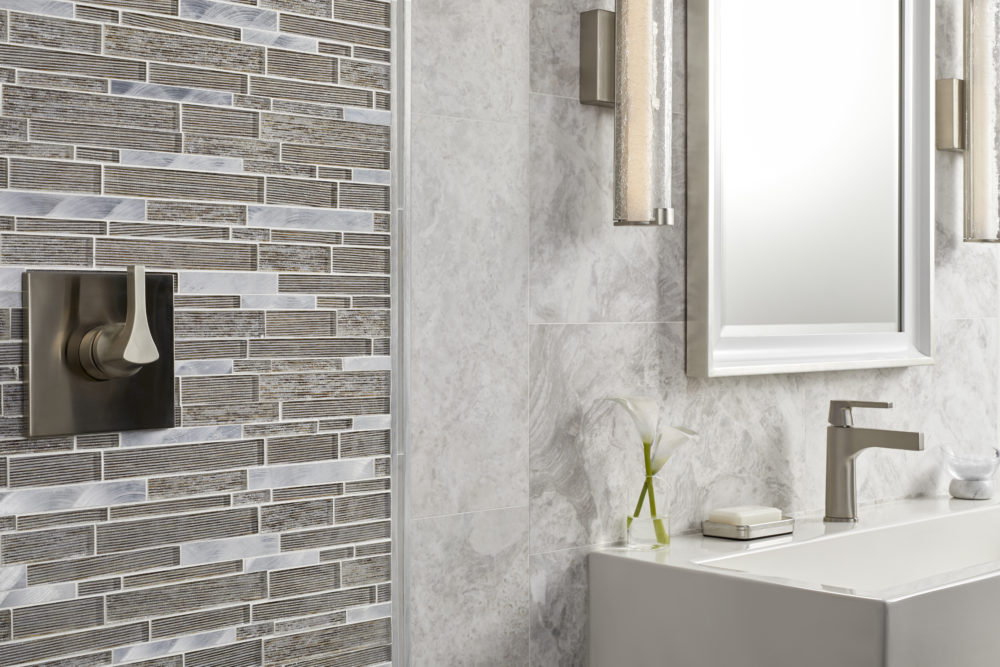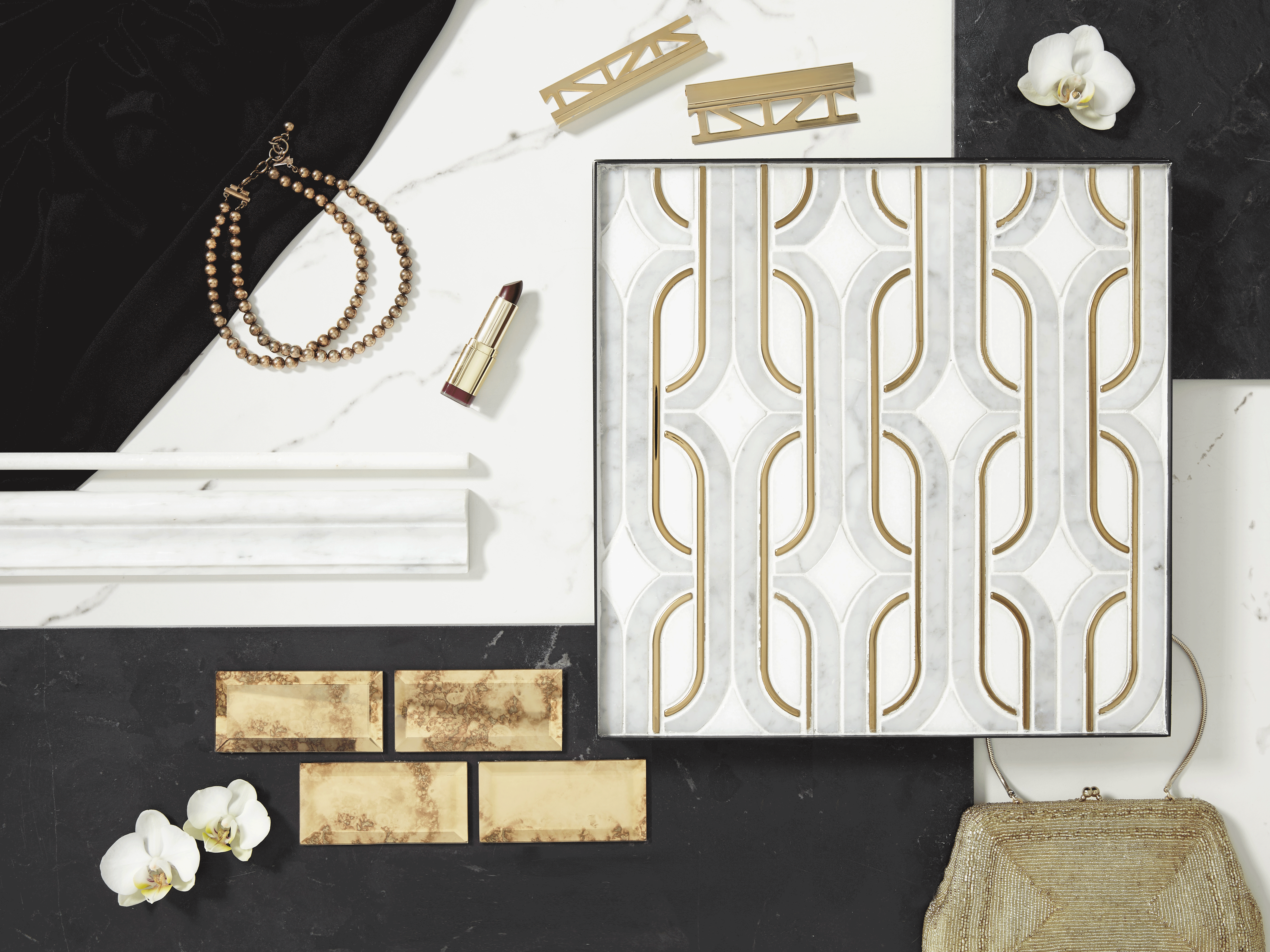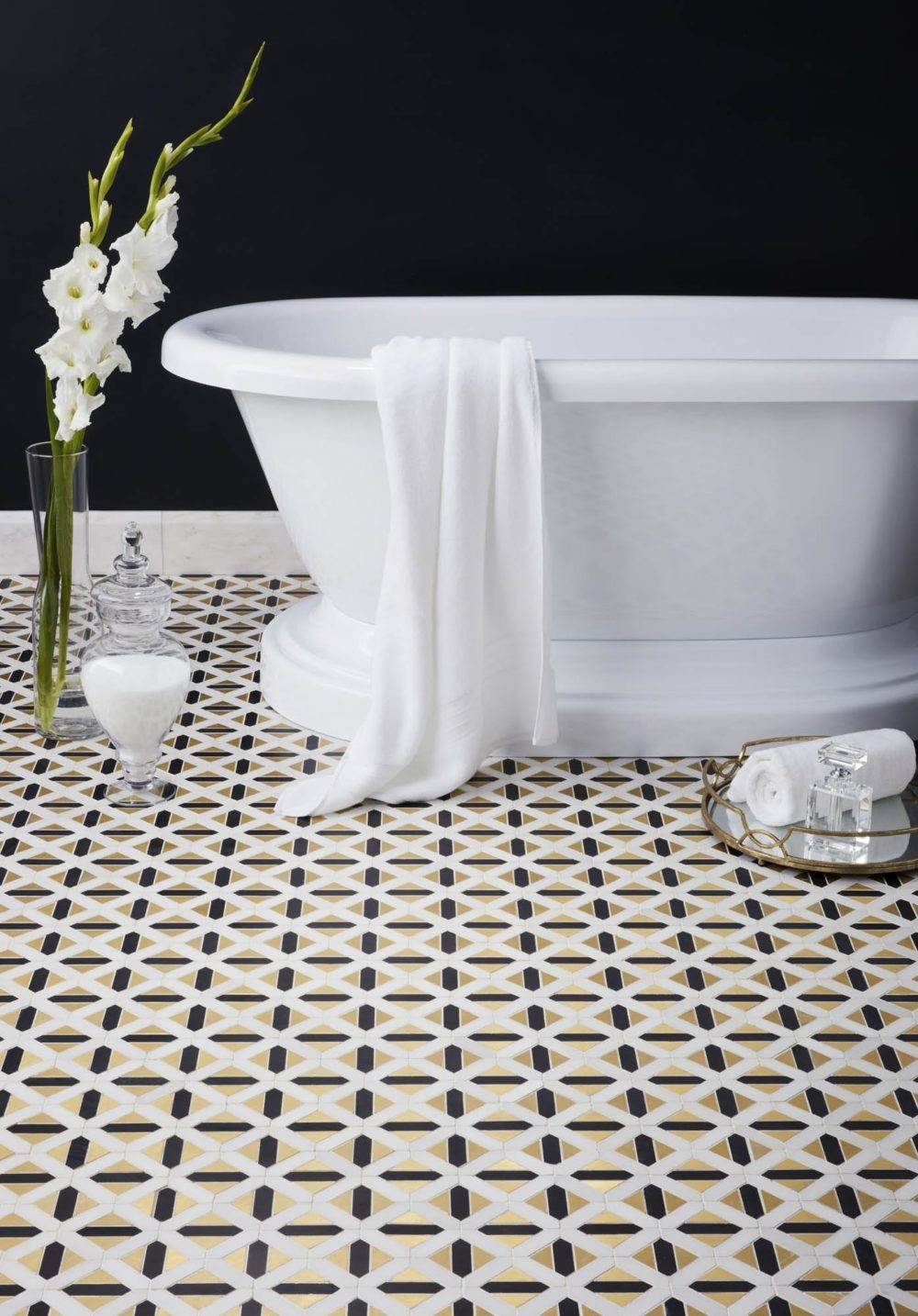The post Guide to Tile Finishes appeared first on The Tile Shop Blog.
]]>Types of finishes
Finishes, or different effects on the surface of a tile that alter its appearance, are generally divided into ceramic, porcelain and other man-made tiles vs. stone categories because of the different ways the materials can be treated. First, we’ll explore the processes that define stone finishes and then look at man-made tiles.
Stone
Stone tile with a polished finish has been passed under a series of polishing wheels with increasingly finer pads using water and polishing compound to assist in the process. This results in a smooth and shiny tile, perfect for adding a touch of luxury and glamour to formal and traditional spaces. Marble is a one type of stone that is often polished.


Satin finishes are produced through the same process as polished but using fewer polishing wheels. This lends a softer and less shiny appearance to the tile, the perfect balance between polished and honed.

Honed tiles go through the same process as polished and satin but with even fewer wheels that result in a smooth matte finish. This is the most casual finish of the three, reflecting very little light and contemporizing a design.


For a brushed finish, stone is run under wheels with metal bristles to achieve an orange peel-like finish. Benefits of a brushed tile are that its texture provides softness, it handles wear and tear and has a relaxed character.

To obtain a tumbled finish, tiles are put into large drums filled with aggregate and shaken. The aggregate wears down the surface of the stone, giving it a rough surface and more rounded edges. Tumbled stones offer increased traction, hide imperfections and flawlessly coordinate with rustic décor.


We’re going au naturel with this one. With natural finish stone tile, what you see is what you get. Nothing is done to the surface of these tiles, and, besides being cut to size, they’re just like they looked when they were quarried. Natural tiles give an authentic and outdoorsy look to your space. Slate is a common example of a natural finish stone.


Filled and unfilled are not exactly finishes, but they alter the surface of a tile so they’re worth mentioning and defining here. Filled stone has its natural crevices and holes filled with an epoxy resin mixed with stone dust in a color that closely resembles the stone’s natural color. This makes the tile easier to clean and install. Unfilled stone is left in its natural state, voids and all. This allows you to choose to fill it with the grout color of your choice or leave it in its rustic, raw state for a unique look.
Here, you can see the difference in appearance of an unfilled travertine compared to a filled travertine. Bucak Silver Honed Unfilled Travertine, on the left, has visible holes and crevices on its surface, whereas Bucak Light Walnut Honed Filled Travertine, on the right, has a lighter colored compound filling in these areas.


Ceramic and Porcelain

Polished tiles are double fired, first with the desired pattern or color and then with a clear coat. Afterwards, they go through the same polishing process as stone, passing under polishing wheels with water and polishing compound. Lastly, the tiles are sealed to retain their appearance. Stone-look porcelain or ceramic tiles are often in polished finishes to mimic the look of natural stone.

A glossy finish is different from polished in that it is created with a glossy glaze instead of a polishing wheel process. Depending on the texture of the tile, gloss glazes can pool in areas, creating thicker and thinner areas of glaze and variations in coloring.

Matte tiles are covered in a non-shiny glaze that is applied with an ink jet machine or in a waterfall stream glazing method. This process yields tiles with a flat finish that do not reflect light and offer a contemporary look.

Multifired tiles are one of the most exciting technological advancements in the industry in recent years. They’re so interesting, we devoted a whole blog post to them! These are tiles that go through more than two firings in a kiln, usually to give them 3-D texture, metallic finish or another interesting effect that is not possible with just one or two firings.

An anti-slip surface is perfect for tiling in wet areas like bathrooms, entryways or mudrooms. They’re also great if aging in place is a consideration in your home. A fine grit or sand is added to a matte glaze to create a rough, gripping texture on the tile.

Textured tile is made by pressing materials into a mold that give a textured effect, such as that of natural stone or wood. Then it’s glazed and fired to achieve the desired look. The below tile is actually a porcelain that has been textured to look like a tumbled stone.

Congratulations! You’ve just completed a crash course in natural stone and man-made tile finishes. If your head is spinning, don’t worry. Our tile experts are waiting in your local store to help you design your next project and choose your perfect tile. Schedule a design consultation or stop in today.
The post Guide to Tile Finishes appeared first on The Tile Shop Blog.
]]>The post Gilded Glamour: How to Tile in Art Deco Style appeared first on The Tile Shop Blog.
]]>
Featured Mosaics: Streamline, Moderne Deco, Skyline
Gilded Glamour, a Tile Shop signature style, blends 1920s art deco design elements with details of modern luxury—and, of course, stunning tile. A gilded touch, which literally means covered in gold, is a hallmark this style is based on. Think the opulence of the Great Gatsby meets the architectural style of the Chrysler Building with a thoroughly current point of view.

Photo by Jonathan Pease on Unsplash
Elements that Define Gilded Glamour
Commonly observed in visual arts, architecture and design, art deco first became popular around World War 1 in France. Then, it was the epitome of luxury, glamour and beautiful craftsmanship. Today, this timeless style still reflects these same aspirational qualities largely defined by five major design elements: geometric shapes, black and white, polished metal, mirrors and shine. Incorporating these elements into a design infuses a space with old-world elegance and allure.
Top Tiles to Get the Gilded Glamour Look
Select tiles from one or more of the below categories, and you will have more than enough inspiration for a Gilded Glamour space of which the Great Gatsby would be envious. Use our recommended products or employ these design elements to create a unique look of your own.
Geometric Shapes
Geometric shapes are defined by simple lines, curves or outlines. The versatility of these interesting shapes makes it easy to customize a look anywhere along the spectrum from subtle to bold. To achieve the Gilded Glamour look, use geometric shapes alongside another art deco design element, like black and white or touches of gold, to highlight the lines. Even with all three art deco design elements in the image below, the overall appearance is elegant and clean. Squares, diamonds, hexagons and any geometric mosaic tiles are a good place to start.

Featured: Corbusier Mosaic
Black and White
Tiling in black and white creates contrast, highlights shapes and lends vintage appeal to a design. Avoid too many bold elements competing in a space with a simple black-and-white base that provides simplicity. A black-and-white mosaic, a bold mix of black and white tiles or an all-over wall or floor in either hue are a few options that create varying degrees of boldness in your look. Black and white get an extra jolt of glamour when they’re in a reflective material or mixed with metal.
Polished Metal
Polished metals, especially gold, are a quintessential feature of Gilded Glamour style and perfect for adding a gilded touch. Incorporate a metallic accent almost anywhere, from tile to shower heads to the vanity. Hints of soft brushed gold peppered throughout the bathroom below tie the whole space together elegantly.

Featured: Tempesta Neve Marble Mosaic, Bulevar White, Tempesta Neve Somerset, Tempesta Neve Barnes, Tempesta Neve Amalfi Mosaic, Bianco Carrara Curb

Featured: Bulevar White
Dural metal profiles are another decadent way to sprinkle bits of metallic shine throughout a tile design. This subtle sparkle elevates the entire space.

Featured: Dural Metal Profiles, Ashford Carrara
Reflection
Not only does it open up a space, reflection adds an element of shine which perfectly complements the luster of Gilded Glamour. Plus, mirrors and reflective elements allow a small or dark room to feel brighter and lighter. As with all the elements of art deco, the extent to which you use mirrors is up to you. A touch of mirrored tile serves as an accent piece while a fully mirrored wall becomes a statement. Take a cue from this design. The mirrored tiles are a bold element so the rest of the design is simple and monochromatic.

Featured: Camilla w/ Mirror, Antique Mirror Bevel

Shine
Polished stone, iridescent finishes, metallic details—shine is an integral part of Gilded Glamour because it serves to add the luster that enhances a space. Polished marbles and other stones define rooms with subtle shine and retain a neutral hue while bright and bold tiles make a more dramatic statement. Pair tiles with shine with other reflective elements sparingly to avoid competing focal points. Below, the crisp white marble is the perfect complement that lets these gold tiles sparkle.
Our Take on Gilded Glamour
Inspired by a modern take on art deco, The Tile Shop’s design manager, Kirsty, envisioned an elegant bathroom with touches of gold and lots of rich marble. Since it’s impossible to create a display with every tile we carry, she used this inspiration to design a visual that would spark ideas for our customers. It turned out so beautifully that, before long, this design dream became a reality.

An artist’s interpretation of our Gilded Glamour bathroom.
This stunning design has everything we love about art deco in a softer, more modern style. The ornamental opulence of Gilded Glamour is visible in the touches of soft brushed gold and the art deco mosaic, which was inspired by a traditional motif. The floating vanity, light fixtures and cool-grey marble modernize the style. The sleek, rounded corners of the mirror mimic the shape of the mosaic and the gold accents coordinate throughout, effectively creating a cohesive look. Layered trims accent the Moderne Deco mosaic on the framed shower wall and in the functional recessed shelf, creating another luxurious detail.
The result is an elegant and soft take on art deco style that feels timeless and modern at the same time.

Featured: Moderne Deco, Verona Blanco, Roman Silver

From an idea to an artist rendering to a real-life installation, the evolution of this idea is dazzling.
Ready to add some modern Gatsby glamour to your space? Schedule a design consultation or stop into your closest store to get inspired and start your project today.
The post Gilded Glamour: How to Tile in Art Deco Style appeared first on The Tile Shop Blog.
]]>
